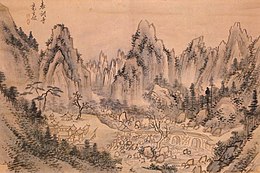19:
170:
211:, Mount Kumgang became a major tourist site, and the temple (known by its Japanese pronunciation as Hyōkun-ji) received many visitors to admire its beautiful setting and architecture. Because of this, it underwent significant restoration work funded by the Japanese administration.
214:
Pyohunsa was the only one of the four great temples of Mount
Kumgang to survive the Korean War. The others were completely destroyed by US bombings of the area, though Singyesa has since been rebuilt. Today, it is still a major point of interest for any visitor to Mount Kumgang.
185:
352:
184:, who viewed the Kumgang mountains as sacred. Enlarged over the years, it underwent many successive restoration, including one in 1778. Eventually it became known as one of the
485:
353:
https://web.archive.org/web/20110724174145/http://www.koreanbuddhism.net/jokb/press/view.asp?article_seq=955&page=1&search_key=&search_value=
495:
446:
490:
369:
500:
410:
364:
423:
402:
158:
26:
234:
97:
18:
200:. Pilgrims were soon flocking to the temple, and eventually, it financed the construction of the smaller
225:, a Buddhist hermit who organized bands of monks to fight back the invading armies of Japanese warlord
208:
290:
138:
111:
388:
8:
433:
226:
245:
Several of the 20 original halls are no longer extant. Among the remaining ones, are:
398:
409:. 10 volumes, 2800 pages. What is said about Pyohunsa can be accessed through this
428:
307:<표훈사 (表訓寺)> as #43 in the 《Geumgang Four Counties Album 금강사군첩(金剛四郡帖)》, 1788
153:, it is the only one of Mount Kumgang's four great temples to have survived the
286:〈Geumgangnaesanchongdo 金剛內山總圖〉 in the 《1711 Pungakdo Album, 신묘년풍악도첩, 辛卯年楓岳圖帖》
479:
461:
448:
142:
221:
169:
304:
201:
146:
280:
230:
154:
79:
76:
73:
189:
438:
180:
Pyohunsa was founded in 670 under the fervently
Buddhist kingdom of
298:
193:
174:
197:
52:
276:
Pyohunsa was depicted by several Korean painters. Among them:
181:
150:
66:
357:
330:
387:
Korean
Buddhist Jogye Order Headquarters, ed. (2011).
116:
102:
204:further up the mountain to accommodate the excess.
149:. Founded in the 7th century under the kingdom of
477:
318:
486:Buildings and structures in Kangwon Province
363:
336:
71:
57:
271:
249:Banyabojeon, 반야보전 (般若寶殿), the Main Hall,
168:
17:
370:Encyclopedia of Korean National Culture
478:
386:
324:
218:In the temple's cemetery stands the
186:Four Great Temples of Mount Kumgang
13:
14:
512:
496:National Treasures of North Korea
424:National Treasures of North Korea
159:National Treasures of North Korea
395:North Korean traditional temples
27:National Treasure of North Korea
491:Buddhist temples in North Korea
117:
103:
1:
346:
501:7th-century Buddhist temples
240:
7:
417:
10:
517:
261:Eosil Pavilion, 어실각 (御室閣),
258:Seven Stars Pavilion, 칠성각,
164:
157:. It is listed as the #97
233:. The stupa is listed as
128:
110:
96:
91:
87:
72:
65:
58:
51:
46:
42:
37:
311:
209:Japanese colonial period
291:Pungaknaesan chongramdo
272:Joseon period paintings
220:Stupa of the Venerable
462:38.63028°N 128.06778°E
358:http://www.cybernk.net
177:
173:The temple as seen by
139:Korean Buddhist temple
29:
264:Neungparu, 능파루 (凌波樓),
172:
21:
367:[Pyohunsa].
267:Pandobang, 판도방 (判道房)
98:Revised Romanization
467:38.63028; 128.06778
458: /
439:김홍도의 금강사군첩(金剛四郡帖) 5
434:Korean architecture
25:Buddhist Temple, a
255:Yeongsanjeon, 영산전,
227:Toyotomi Hideyoshi
178:
32:North Korea Temple
30:
132:
131:
124:
123:
112:McCune–Reischauer
47:North Korean name
508:
473:
472:
470:
469:
468:
463:
459:
456:
455:
454:
451:
408:
381:
379:
377:
340:
337:EncyKor/Pyohunsa
334:
328:
322:
252:Myeobujeon, 명부전,
202:Chongyang Temple
137:(표훈사, 表訓寺) is a
120:
119:
106:
105:
89:
88:
83:
82:
61:
60:
35:
34:
516:
515:
511:
510:
509:
507:
506:
505:
476:
475:
466:
464:
460:
457:
452:
449:
447:
445:
444:
429:Korean Buddhism
420:
405:
390:북한의 전통사찰 A B 세트
375:
373:
349:
344:
343:
335:
331:
323:
319:
314:
274:
243:
167:
33:
12:
11:
5:
514:
504:
503:
498:
493:
488:
442:
441:
436:
431:
426:
419:
416:
415:
414:
403:
383:
382:
360:
355:
348:
345:
342:
341:
329:
316:
315:
313:
310:
309:
308:
302:
296:
295:
294:
287:
273:
270:
269:
268:
265:
262:
259:
256:
253:
250:
242:
239:
235:Cultural asset
166:
163:
130:
129:
126:
125:
122:
121:
114:
108:
107:
100:
94:
93:
92:Transcriptions
85:
84:
69:
63:
62:
55:
49:
48:
44:
43:
40:
39:
31:
9:
6:
4:
3:
2:
513:
502:
499:
497:
494:
492:
489:
487:
484:
483:
481:
474:
471:
440:
437:
435:
432:
430:
427:
425:
422:
421:
412:
406:
404:9788996665908
400:
396:
392:
391:
385:
384:
372:
371:
366:
361:
359:
356:
354:
351:
350:
338:
333:
326:
321:
317:
306:
303:
300:
297:
292:
288:
285:
284:
283:as a part of
282:
279:
278:
277:
266:
263:
260:
257:
254:
251:
248:
247:
246:
238:
236:
232:
228:
224:
223:
216:
212:
210:
205:
203:
199:
195:
191:
188:, along with
187:
183:
176:
171:
162:
160:
156:
152:
148:
144:
143:Mount Kumgang
140:
136:
127:
115:
113:
109:
101:
99:
95:
90:
86:
81:
78:
75:
70:
68:
64:
56:
54:
50:
45:
41:
36:
28:
24:
20:
16:
443:
397:]. 養士齋.
394:
389:
374:. Retrieved
368:
332:
320:
301:, fl 1755-85
275:
244:
219:
217:
213:
206:
179:
134:
133:
22:
15:
465: /
365:"표훈사 (表訓寺)"
305:Kim Hong-do
229:during the
207:During the
147:North Korea
141:located on
480:Categories
450:38°37′49″N
411:Naver link
347:References
325:Jogye 2011
281:Jeong Seon
231:Imjin Wars
155:Korean War
135:P'yohun-sa
53:Chosŏn'gŭl
453:128°4′4″E
293:〉 (1740s)
241:Structure
190:Changansa
118:P'yohunsa
418:See also
376:26 March
362:EncyKor
299:Choi Buk
194:Singyesa
175:Choi Buk
104:Pyohunsa
38:Pyohunsa
23:Pyohunsa
198:Yujomsa
165:History
413:(표훈사).
401:
237:#306.
67:Hancha
393:[
312:Notes
222:Sosan
182:Silla
151:Silla
399:ISBN
378:2021
196:and
59:표훈사
482::
192:,
161:.
145:,
407:.
380:.
339:.
327:.
289:〈
80:寺
77:訓
74:表
Text is available under the Creative Commons Attribution-ShareAlike License. Additional terms may apply.

